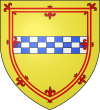Clan Stuart of Bute
| Clan Stuart of Bute | |
|---|---|
 |
|
| Motto | Nobilis Est Ira Leonis (The Lions Anger is Noble) |
| Profile | |
| Region | Highland |
| District | Argyll |
| Plant badge | Unknown |
| Chief | |
 |
|
| John Crichton-Stuart | |
| 7th Marquess of Bute | |
| Seat | Rothesay, Argyll and Bute |
Clan Stuart of Bute is a Highland Scottish clan and is a branch of the larger Clan Stewart.
The Stewards or seneschals of Dol in Brittany came to Scotland through England when David I of Scotland returned in 1124 to claim his throne. In Scotland they rose to high rank, becoming High Stewards of Scotland. Through a marriage to Marjory, daughter of king Robert the Bruce, the Stewarts acquired the throne of Scotland when David II of Scotland, only son of Robert the Bruce died.
Robert Stewart who reigned as Robert II of Scotland gave to his younger son, John, the Isle of Bute, the Isle of Arran and the Isle of Cumbrae. The king conferred these lands into a county and made his son the sheriff. This was confirmed in a charter by Robert III of Scotland in 1400.
James Stewart was sheriff of Bute between 1445 and 1449. He was succeeded by his son, William, who was also keeper of Brodick Castle on Arran. His son was Ninian Stewart who was confirmed in the office of sheriff of Bute as well as the lands of Ardmaleish, Greenan, the Mill of Kilcatten and also Corrigillis. Ninian Stewart was created hereditary captain and keeper of Rothesay Castle on Bute in 1498 by James IV of Scotland, an honour still held by the family today, and shown in their coat of arms.
Ninian Stewart married three times. In 1539 he was succeeded by his son James Stewart. James suffered during the feud between the Earl of Arran who was regent of Scotland and the Earl of Lennox. James Stewart was succeeded by his son, John, who attended the Parliament in Edinburgh as the Commissioner for Bute. The family favoured the spelling of the name as Stuart, which was introduced by Mary, Queen of Scots, and is still used by the present chiefs.
...
Wikipedia
